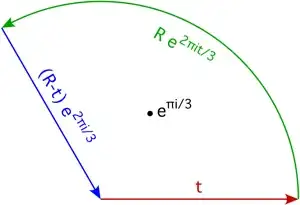This one may also be solved using a keyhole contour as follows. Consider
$$\oint_C dz \frac{\log^2{z}}{1+z^3}$$
Note that we are using the square of the log here. Over the keyhole contour, note that we pass over the positive real axis twice: once for $\arg{z}=0$, then back again for $\arg{z}=2 \pi$. One can show that the integral over the circular contours (large and small) will vanish as the radius of the large contour goes to infinity, and the small one goes to zero.
In the meantime, we are left with the integrals over the real axis. Note that the log function is multivalued in the following sense:
$$\log{(x e^{i 2 \pi})} = \log{x} + i 2 \pi$$
so that the integral over $C$ boils down to
$$\begin{align}\oint_C dz \frac{\log^2{z}}{1+z^3} &= \int_0^{\infty} dx \frac{\log^2{x}}{1+x^3} - \int_0^{\infty} dx\frac{(\log{x}+ i 2 \pi)^2}{1+x^3}\\ &= -i 4 \pi \int_0^{\infty} dx \frac{\log{x}}{1+x^3} + 4 \pi^2 \int_0^{\infty} dx \frac{1}{1+x^3} \end{align}$$
Don't worry about that second integral on the RHS for now. As you can see, though, we have reproduced our original integral.
Now, by the Residue Theorem, the contour integral is equal to $i 2 \pi$ times the sum of the residues of the poles of the integrand within $C$. We have poles where $1+z^3=0$, but it is very important how we express them. The poles are at $e^{i \pi/3}$, $-1$, and $e^{i 5 \pi/3}$. Note that in the latter, we did not use $e^{-i \pi/3}$, although in most cases it wouldn't matter. Here, because we are dealing with a multivalued function, it does.
The residues at these simple poles are as follows:
$$\mathrm{Res}_{z=-1} = \frac{-\pi^2}{(1+e^{i \pi/3}) (1+e^{-i \pi/3})}$$
$$\mathrm{Res}_{z=e^{i \pi/3}} = \frac{-(\pi^2/9)}{(e^{i \pi/3}-e^{-i \pi/3}) (1+e^{i \pi/3})}$$
$$\mathrm{Res}_{z=e^{-i \pi/3}} = \frac{-(25\pi^2/9)}{(1+e^{-i \pi/3}) (e^{-i \pi/3}-e^{i \pi/3})}$$
I will spare you the arithmetic involved in combining and simplifying these. Our equation for the integrals becomes
$$-i 4 \pi \int_0^{\infty} dx \frac{\log{x}}{1+x^3} + 4 \pi^2 \int_0^{\infty} dx \frac{1}{1+x^3} = i 2 \pi \left ( \frac{4 \pi^2}{27} - i \frac{4 \pi^2}{3 \sqrt{3}} \right ) $$
Equating real and imaginary parts, we get
$$\int_0^{\infty} dx \frac{\log{x}}{1+x^3} = -\frac{2 \pi^2}{27}$$
$$\int_0^{\infty} dx \frac{1}{1+x^3} = \frac{2 \pi}{3 \sqrt{3}}$$
So we get a bonus integral for free.
